Critique Submissions‚ December, 2000
This page contains submissions made during December, 2000 from photographers who wished to have their photographs reviewed by the publisher of this site,Michael Reichmann.For additional details see theCritique / Contestpage.
The December winner of a complimentary 1-year subscription to theLuminous Landscape Video Journalwas Dai Rhys.
‚ For previous contest winners and past month’s entries select from the list at left. ‚
Dai Rhys
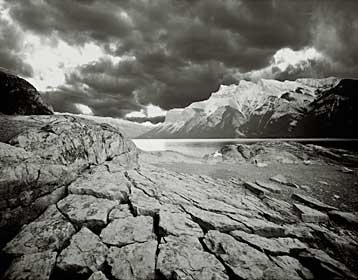
Dai Rhys Bragg Creek, Albertadai@icalgary.com Lake Minewanka, Alberta, Canada 8X10 T-Max in Deardorff with 121/f8 Super Angulon. Photoshop 5.0 quadtone. "The proper artistic response to digital technology is to embrace it as a new window on everything that’s eternally human, and to use it with passion, wisdom, fearlessness and joy" -Ralph Lombreglia, in Atlantic Unbound
Michael’s Critique
This is a stunningly beautiful image. I wish I would see a 20X24" print. Often large format photography is about texture, tonality and detail. In this case it’s all of that but with a beautiful composition and great subject as well. Perfectly executed and very impressive!
You can add your own comments on Dia’s photograph on the Critique section of ourDiscussion Forum.
Ã…ke Vinberg
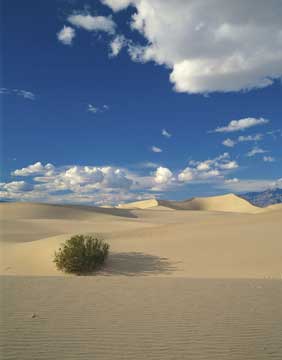
Ã…ke Vinberg
Stockholm, Sweden
ake.vinberg@home.se
Location: Death Valley, California
Date: October, 1998
Technical: Toyo-Field AX 4×5 inch view camera. Nikon 135/5.6 lens.
Polarizer, probably also B2 warming filter. Exposure time unrecorded at f/45, on Kodak E100SW. Scanned on an Imacon Flextight by Dox Imaging in Stockholm.
Comment: I spent five hours out in the dunes that afternoon. Most of the afternoon was overcast, and when the sun finally dipped below the clouds there was not much time left before the sun disappeared behind the mountains in the west. Out of six photos, I like this one the best. I think it is the contrasts – in texture, shape, color, and distance – that grab my eye. Needless to say, it takes an 11×14" enlargement to fully appreciate it. A comment on composition: The idea was to achieve some kind of diagonal balance between the bush in the foreground and the cloud (lower left – upper right, near – far). When I look at the image I keep wondering if I should have waited for another cloud to position itself properly. The near-far dimension seems to run through the bush and the far dunes rather than involving the upper-right cloud.
Michael’s Critique
This is a classic large format image from Death Valley. Nicely seen and very well executed. The sky carries the greatest interest. The mid-ground is next, and I like the texture and feel of the dunes ands shadow of the bush. I’m less enamored of the foreground which seems flat and doesn’t contribute to the overall mood. I’d be tempted to crop it from the print or to have moved in with a wider angle lens at the time of shooting to exclude it.
You can add your own comments onƒâ€¦ke’s photograph on the Critique section of ourDiscussion Forum.
Marty Friedman
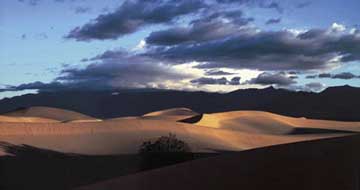
Martyf2938@aol.com
Pleasantville, New York
The image was taken at sunrise at the dunes in Death Valley, with a Wisner 4×5 camera and Provia film.The light of course, was very fleeting and changed rapidly. I didn’t know what I had untill later when the film was developed, and I could study the images. I got the most from the dark film by using photoshop and adjusting the curves.
Michael’s Critique
Another submission from Death Valley. This one is dramatic and compelling. Marty has handled the strong contrast very well. I like the way that the frame appears to be divided into multiple layers because of the alternating bright and dark segments. The contrasting warmth of the central dunes works nicely against the coolness of the sky.
You can add your own comments on Marty photograph on the Critique section of ourDiscussion Forum.
Todd
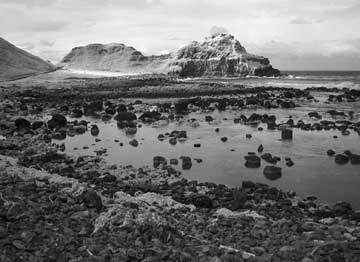
Northern coast of Co Antrim Northern Ireland near the Giants Causeway. It was taken with an Olympus C2020 digital camera with an IR filter. Exposure details: F2,1/30 sec, 37mm(equiv.). The only modifications to the image were a 2 degree rotation to adjust for a non-level horizon and a resolution reduction.
Michael’s Critique
This is a fairly mundane image though it has potential. If it had been shot on medium or large format the texture and detail could have been interesting, but since it was done with a moderate resolution digital camera, the resolution is adequate but not sufficient for that to be enough to carry the image.
You can add your own comments on Todd’s photograph on the Critique section of ourDiscussion Forum.
Dan Magus
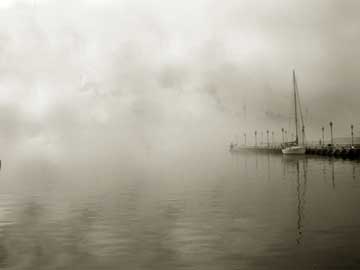
Dan Magus Baltimore, MD USAdan_magus@lcc.com Nikon Coolpix 990. Michael’s Critique
A potentially interesting photograph but let down by poor composition. The point of interest is off to the right of the frame. While the rest of the frame is filled with interesting texture and tonality there’s nowhere for the eye to rest. Unbalanced and ultimately uninteresting. Also, there is something just out of the frame on the left-hand side that is distracting and should have been cropped.
You can add your own comments on Dan’s photograph on the Critique section of ourDiscussion Forum.
Attila Kirjak
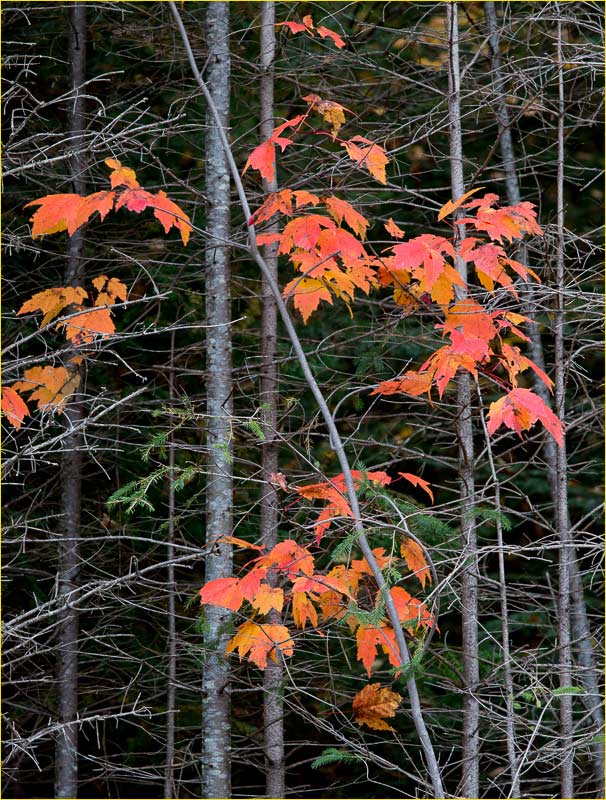
Attila Kirjak
kiru@mailzone.com
http://www.mailzone.com/~kiru
New York
This picture was taken next to the Delavare river (same day as my last month’s submission), my eyes were drawn to this backlit tree in the foggy morning. The slide carries almost a solirized effect, I’m just surprised to see this on a plain slide with no darkroom manipulation. Canon EF 85mm f1.8 lens, Evaluative metering +0.3 overexposure, no filter, tripod, on Provia 100F.
Michael’s Critique
Attila’s submission this month is appealing but ultimately lacks a strong focal point. I like the contrast, but the warmth of the leaves and the coolness of the foggy background aren’t enough to make this image of more than casual interest.
You can add your own comments on Attila’s photograph on the Critique section of ourDiscussion Forum.
Ken Schuster
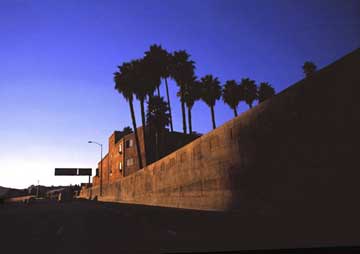
Ken Schuster
Tarzana, California, US
mailto:ken.schuster@att.net
This is on my way home on the Hollywood freeway. In July the sun sets on the asphalt. Sunglasses and a tinted windshield blackens shadows and muffles highlights. Fuji GSW690III (65mm lens) Velvia, under exposed f11 @ 500 pre-focused at 20 feet.
Michael’s Critique
While as a rule I am no longer accepting "cityscapes" as submission to this section, Ken’s submission is graphically very strong and well seen. I’m a sucker for strong graphic images.
You can add your own comments on Ken’s photograph on the Critique section of ourDiscussion Forum.
Erik H. Pronske
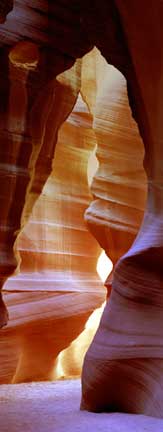
Erik H. Pronske, M.D.
Austin, TX
epronske@austin.rr.com
Technical Data:
Hasselblad X-Pan Camera
90 mm Hasselblad Lens
B+W UV Filter (To protect the lens from all the dust in the canyon)
Gitzo 340 Tripod with Kirk Ball-head
Kodak Royal Gold 100 Film
Description:
I spent a day in June, 2000 photographing in the North Section of Antelope Canyon near Page, AZ. I was finishing up at about 3PM and came upon a gentleman who pointed out that this particular light pattern looked like a grizzly bear. To me on film it is much more apparent than it was in real life (3-D vs. 2-D). I had just received the X-Pan and this was my first real trip with it. I thought that this might make an interesting vertical panoramic.
Michael’s Critique
I take great pleasure in viewing photographs from Antelope Canyon and am also a big fan of the XPan. Eric has done an excellent job, but I’m afraid that I don’t see the Grizzly 🙂
Exposures are tough in this unique location and here the great dynamic range has been handled well. I’ve just returned from a visit toLower Antelopewhich is quite different from Upper Antelope where Erik’s photograph was taken.
You can add your own comments on Erik’s photograph on the Critique section of ourDiscussion Forum.
Amadou Diallo
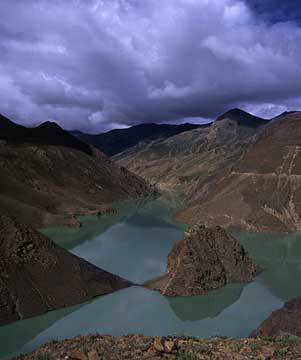
Amadou Diallo
Brooklyn, NY
adiallo@mindspring.com
Rebel 2000 with Vivitar 19-35 lens using an ultra thin polarizer , Velvia @ISO 50, Scanned with a Canon FS2710
Looking out from Simi La mountain pass (13,000+ feet) near Gyantse in central Tibet. Taken during a 16 day mountain bike tour through Tibet and Nepal in July.
Michael’s Critique
This is a fascinating image of a unique location. I might have printed it a bit lighter, but the darkness adds a sense of mystery that intrigues.
You can add your own comments on Amadou’s photograph on the Critique section of ourDiscussion Forum.
Ed Leys
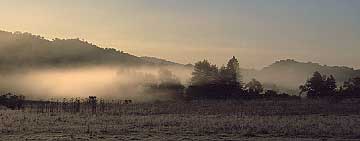
Ed Leys
Milpitas California
eleys@meer.net
Nikon FA; Nikon 28-85mm zoom; Provia 100F exposed at EI 200, push processed one stop; f/11, exposure duration unrecorded.
Perhaps our job, as photographers, is to go looking for luck. To use our eye and our tools to capture our luck in the right rectangle. And, using our skills as best we can, to try to burnish our luck into something that can be taken for art … This bit of luck was located in the frost and the fog, along the early morning road up Mount Hamilton, California.
Michael’s Critique
Ed’s submission this month is close, but regretfully "no cigar". It has some of the needed ingredients‚ warm morning light, a fog bank and a potentially interesting composition. But it lacks compelling subject matter. The foreground is plain, the tree line is not terribly exciting and the sky is bland. A great shot needs to have every component working for it and this frame only has a few of the needed elements at work.
You can add your own comments on Ed’s photograph on the Critique section of ourDiscussion Forum.
Thomas W. Earle
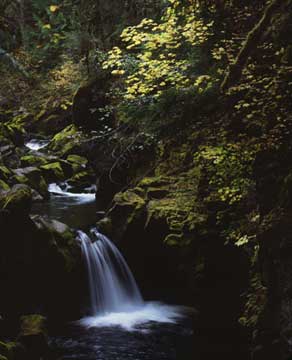
Thomas W. Earle Pendleton, Oregon (USA) twade@bmi.net
This photograph was taken off trail near Toketee Falls in October 2000. Toketee Falls is located east of Roseburg, Oregon. The waterfall is nestled in a small gorge that contains three small waterfalls, only one visible in this shot. It is an absolutely gorgeous area to take photos of all kinds. I will definitely be back next year. Film: Fuji Provia 100F @ ASA 100 Exposure: 1 sec @ f/16 Camera: Pentax 67 Lens: 165 mmMichael’s Critique
I enjoy this photograph. It captures the feel of a wooded glen and waterfall area very well. The exposure is possibly a bit too long at 1 second. I find that 1/8th or 1/4 second usually is best. Wade asked in his covering note about how I might crop this differently. There are a number of alternatives‚ all with possibilities. Possibly a vertical crop with about a quarter of the right side of the frame removed would work best.
You can add your own comments on Wade’s photograph on the Critique section of ourDiscussion Forum.
jay obrien
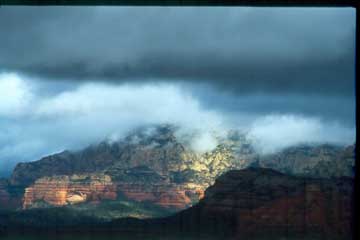
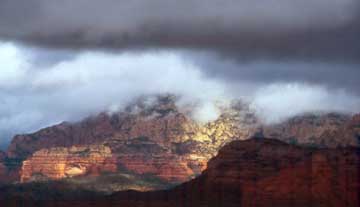
jay obrien
phila., pa
jayobrien587@aol.com
nikon f5, 28-200 tamron lens at 200 aperature priority at f16 fuji provia f100, bogen tripod and head.
photographed on vacation in sedona, arz. my patience was rewarded with this oncoming storm, which produced this terrific light. i was happy that i stayed around a little longer after sunrise to be able to capture this image and others. it made for a great vacation.
Michael’s Critique
Jay took a very nice photograph but from what he submitted it’s hard to tell. Usually if a submission is off-level, has black borders and poor colour balance I reject it. It usually shows a lack of care and attention by the photographer, so why should I bother? This submission suffered from all of these sins. This time though I’m using Jay’s image to illustrate my point by providing a corrected version as well.
Have you ever seen a cyan sky like this? No? So why not spend 10 seconds and correct it? Another 10 seconds adjusting Levels and a bit of cropping and I think we’re closer to what Jay saw when he took the shot.
You can add your own comments on Jay’s photograph on the Critique section of ourDiscussion Forum.
Ed Hyde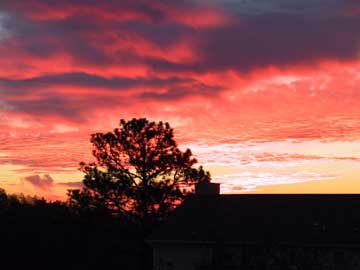
Ed Hyde
Birmingham, Alabama, USA
www.hydes.net
Picture taken with Canon G1 (full auto with flash off) Between 5:15 & 6 :00 AM, 12-1 or 12-2-00. I am an amateur and only use digital equipment.
Michael’s Critique
There was a great sky here, but the colours are so over saturated that it’s taken on a psychedelic look. The tree doesn’t appear to be in sharp focus either. There was potential to the location but I’m hard pressed to suggest how best to fix it.
You can add your own comments on Ed’s photograph on the Critique section of ourDiscussion Forum.
Eric Taylor
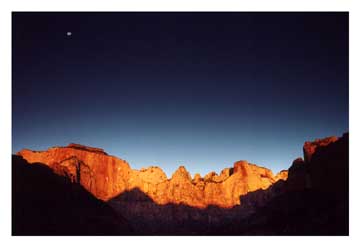
Name: Eric Taylor
City: Toronto, Canada
Email : polky@interlog.com
Camera: Nikon F601
Lense : Sigma 28-70 EX, Cokin 2 stop Gradual ND filter
Tripod/Ballhead: Manfrotto
Film: Kodak Royal Gold 100
Description:
Location is Zion National Park. Subject matter is the ‘Towers of Virgin’ at Sunrise. I was lucky enough to have a moon to add to the composition. I had several exposures which were cropped to just the ‘towers’, but found this to be more pleasing. For people visiting Zion, this is a must see sunrise shot. As the sun rises above the mountains behind you, a brilliant glow is cast on to the "Tower’s" peaks.
Michael’s Critique
This is a dramatic rendition of a classic scene. Eric’s right. The moon does add a needed touch. I feel that the colour of the cliffs is somewhat over saturated. When red-rock sandstone goes that hot I try and tone it down to something a bit more believable.
You can add your own comments on Eric’s photograph on the Critique section of ourDiscussion Forum.
Josh Levy
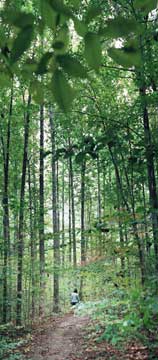
Josh Levy
Chapel Hill, NC, USA
jlevy3@nc.rr.com
Fuji Superia 100 Canon EOS 650, 50mm EF mk II. 6 shots, stitched and perspective corrected with PowerStitch
This shot was taken in Duke Forest in Chapel Hill. I tried to make the shot interesting by including the hiker. Basically, I wanted to try PowerStitch with an extreme vertical composition to test out its perspective controls.
Michael’s Critique
Vertical panoramics, either camera-produced or stitched, are difficult to do well. Josh has done a nice job, though I find the out-of-focus leaves at the top of the frame distracting.
Western art doesn’t have much in the way of thin vertical images, though Japanese art has a legacy of vertical landscapes.
You can add your own comments on Josh’s photograph on the Critique section of ourDiscussion Forum.
Ryan Sawby

Ryan Sawby Phoenix, AZryansawby@worldnet.att.net Image taken handheld with Olympus 3030Z digital camera. I took this on an early morning hike in the Huachuca mountains of southeast Arizona during the monsoon season when everything is lush. These flowers were not abundant, and it was a treat to encounter them as I walked through a meadow. There’s no foliage to speak of, they arise 6-8" off the ground from a thin stem, so the image conveys how they appeared- floating stars on a sea of green. I saw a similar flower composition in the November critiques and liked this one better so I thought I’d give it a shot. I’m intrigued by the symmetry of the petals and the dew drops on their surfaces. This image is raw with the exception of a sharpen filter applied in Photoshop. It seems like it needs to be cropped, but I liked the texture of the green space.
Michael’s Critique
This is a simple and satisfying nature photograph. What I enjoying seeing is the increasing number of photographs taken with mid-range digital cameras. I make no allowances for equipment used, and while I see some digital dogs there are very fine submissions like this one that show that the latest mid-range gear is capable of quite adequate image quality.
You can add your own comments on Ryan’s photograph on the Critique section of ourDiscussion Forum.
Donald Dixon
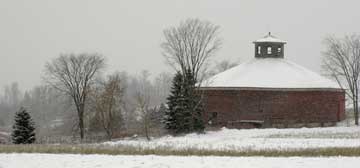
Donald Dixon
Wausau, WI
donauw@dwave.net
Shot on a snowy overcast day in Northern Wisconsin last month. The barn was built by some of the original German settlers to this area and is brick.
Shot with Nikon D1, Exposure: 1/320 sec – F/4.5 , Lens: 28-70mm F/2.8 , Focal Len: 52mm
Michael’s Critique
Landscapes including the hand-of-man can be difficult, as can winter scenes. This one captures the placid feel of a winter’s day in the country. Nicely done.
You can add your own comments on Donald’s photograph on the Critique section of ourDiscussion Forum.
Leigh Perry
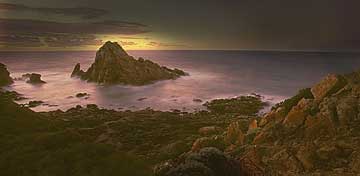
Leigh Perry
Sydney, Australia
lperry@breakpoint.com.au
Provia 100F, Canon 17-35L lens, Canon EOS 50. Exposed 20 seconds at f/16. Cropped to poor man’s panoramic.
With the sun setting at sea, coastal landscapes in Western Australia are bathed in a warm light we never see on the east coast of Australia. Rocks and trees take on a lucent quality. About to leave a sunset shoot, I noticed the nearby lichen rocks still glowing in the last gasp of light. They seemed a harmonious counterpoint to the dramatic Sugarloaf Rock.
Michael’s Critique
This is a remarkable photograph. It simply glows. The perspective and lighting are superb.
While at first I thought that some considerable digital "enhancements" had been done Leigh has written that, "Digital processing is limited to the traditional tools of cropping, levels adjustments, and dodging / burning".
As I said, remarkable.
You can add your own comments on Leigh’s photograph on the Critique section of ourDiscussion Forum.
Michael Barnett
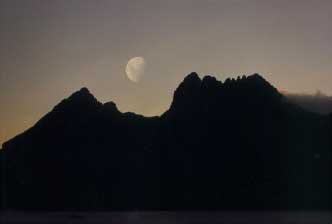
Michael Barnett
Melbourne, Australia
mikebear@netspace.net.au
Nikon F90, Nikkor 300 mm 1:4 telephoto and Nikkor 28-70 mm zoom (double exposure), Kodak Ektapress 100 film , Manfrotto tripod
Cradle mountain is instantly recognisable, even if you’ve only seen it just the once. Nestled in the centre of Tasmania in a World Heritage listed area, it is breath-taking, awe inspiring and not for the faint of heart if you intend to climb it (which I didn’t). Having a clear sky and large bright moon gave me the inspiration for this photograph. I love the wisp of cloud just to the right of the mountain coloured by the light from the setting sun.
Michael’s Critique
Capturing the moon with detail and avoiding a burned out or too black sky is always a challenge. Having an interesting foreground completes the level of difficulty. Michael has carried it off well.
I appear to have a number of readers from Oz like Michael and Leigh. It’s a pleasure to view their landscape work because for us North Americans the locations shown are novel and fascinating. I’ve been to Australia a couple of times but always on business, and never with photography as a primary mission. One day!
You can add your own comments on Michael’s photograph on the Critique section of ourDiscussion Forum.
Nathan Wajsman
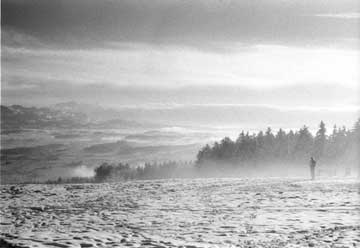
Nathan Wajsman
Herrliberg (Switzerland)
wajsman@webshuttle.ch
Leica M6, 50mm Summicron lens, film: Ilford SFX developed in Ilfotec DD-X 1+9, dark red filter (#29). Exposure unrecorded.
This was taken in early December at Pfannenstiel, a small mountain (around 850 meters altitude) near Zurich. It was the first snow of the season, and later in the day the place was teeming with playing children. But early in the morning the scene was very solitary–just me and the person in the picture.
Michael’s Critique
Boy, does this feel cold. The spindrift, the glaring light and the monochromatic treatment simply accentuate the mood.
My only criticism is that the heavily footprint-marked foreground doesn’t add anything to the composition. I would be tempted to crop most of it.
You can add your own comments on Nathan’s photograph on the Critique section of ourDiscussion Forum.
Miles Hecker
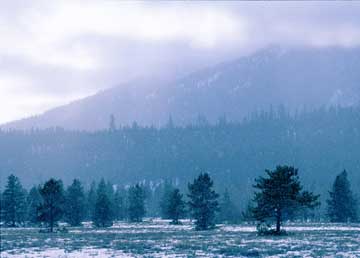
Miles Hecker
mhecker@acad.cc.whecn.edu
Contax Aria 100-300mm, Velvia, Bogen tripod, 1/125 f5.6, shot 11-23-2000
We went for a ski tour on Thanksgiving day. Despite the inclement weather, I took my photo gear. Three miles in near Jenny Lake, in Grand Teton National Park, the storm began to break. The shafts of gentle light silhouetted a ridge at the base of Grand Teton Winter is a quiet time. A time of gentle beauty, subtle lighting and of course snow.
Michael’s Critique
Another winter scene‚ quite appropriate for the season. This one too says "cold". I like the feel, but the composition is a bit weak. There’s no center of interest.
You can add your own comments on Miles’ photograph on the Critique section of ourDiscussion Forum.
Tillman Kleinhans
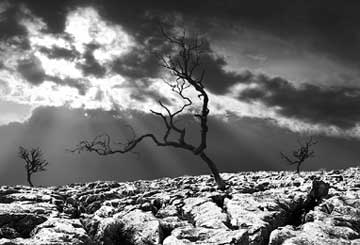
Tillman Kleinhans LRPS DPAGB St. Helens, Merseyside, UK.kleinhans@cableinet.co.uk www.tkimages.co.uk Canon EOS5 + 28-105 USM, Taken early one morning in March, the image shows the desolation and harshness of that area of the Yorkshire Dales. Contrast has been increased to emphasise those properties that give the area its uniqueness.
Michael’s Critique
A dramatic and well excited photograph. There’s nothing that can be added or subtracted. Beautifully done.
You can add your own comments on Tillman’s photograph on the Critique section of ourDiscussion Forum.
Paulo Bizarro

Paulo Bizarro
EOS 1n 50 macro E100SW f/16 @ 1/250 sec.
The shot was taken last February in Portugal’s SW coast, and area thus far quite well preserved for wild life and scenics. The wind was blowing quite hard and a SW storm was approaching.
Michael’s Critique
Paulo’s images are always powerful. The layers of cloud, land and waves as well as the contrasting tonalities and contrasts creates a quite dramatic image. The point of land on the lower right and the dark cloud center left are like arrows into the frame. A very strong and appealing image.
You can add your own comments on Paulo’s photograph on the Critique section of ourDiscussion Forum.
David Cassidy
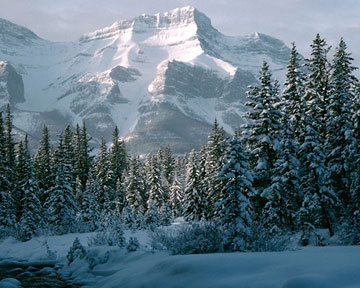
David Cassidy
Fountain Valley, California
dlcassidy14@yahoo.com
Canon AE-1, Kodachrome slide
Mountain Morning near Banff
Michael’s Critique
A well executed image but without a strong statement. I like the feel though. My real complaint is that the colour balance could be somewhat less cyan.
You can add your own comments on David’s photograph on the Critique section of ourDiscussion Forum.
Anders Wahlström

Anders Wahlström
Stockholm
Sweden
email caiw@spray.se
Canon Eos 1
EF 28mm 2.8
Ektachrome 100
The picture is taken in the archipelago where i have my summer house. I do spend time there in the winter to as you can see. Late afternoon the sun is setting.
Michael’s Critique
This photograph strikes a strong cord with me as it looks very much like the Muskoka Lakes region in Ontario, Canada where I vacation. Beautiful composition, beautiful light‚ an excellent photograph.
You can add your own comments on Ander’s photograph on the Critique section of ourDiscussion Forum.
Nancy Patrick
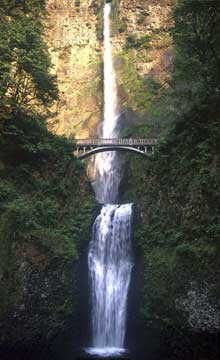
Nancy Patrick
nancypa@trib.com
Multnomah Falls
Canon T90, 28-85mm Canon FD, Velvia, 1/15, F8
Taken in the Columbia River Gorge in late afternoon when the sun was bathing the falls with a warm glow. It is a difficult picture to frame do to the foreground railing and height of falls.
Michael’s Critique
My main problem with this photograph is that it’s too "dead on" in perspective, which makes it flat, reducing dimensionality. Waterfalls are tough to do well, particularly skinny ones like this one. Also, there are to many conflicting tonal areas. Also, though the bridge is a unifying factor it’s too dead-center in the frame to be an appropriate center of interest.
You can add your own comments on Nancy’s photograph on the Critique section of ourDiscussion Forum.
George Kmetz

George Kmetz
Huntington,CT
Waterfall in Southern Catskill Mts". ..Nikon F3, Nikkor 75-300 f4.5-5.6, Velvia at 50ASA, B+W Polarizer, tripod.
Michael’s Critique
A lovely, well executed photograph. In addition to an appealing composition the contrast of the warm leaves and the cool water makes for an appealing image.
You can add your own comments on George’s photograph on the Critique section of ourDiscussion Forum.
A. Sanjuan
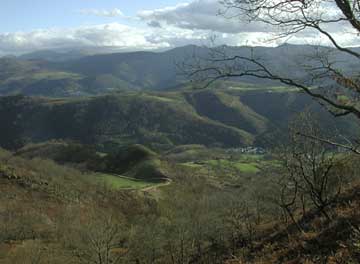
A. Sanjuan
Donostia-San Sebastian, Spain
asanjuan@altavista.com
Ituren (Navarra), Spain
Nikon Coolpix 880, f/7.8, ISO 100, 1/150 sec
This is a view of a little town near where I live. We have a small house in the slope of the mountain where we spent brief days. There are two modifications to the image. A little crop to get rid of a branch, and a little Cyan level adjustment.
Michael’s Critique
What a lovely valley. The foreground is confusing but I like the rest of the composition and the varying shades of green. Not a great image, but an enjoyable one.
You can add your own comments on Alfredo’s photograph on the Critique section of ourDiscussion Forum.
Dennis McKenzie
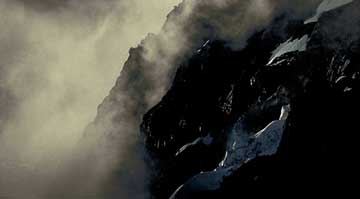
Dennis McKenzie
Wasilla, Alaska, USA
djmckenzie@webtv.netTaken with. Nikon F4s, 400mm nikon lens, 2xteleconverter, fuji provia f 100 pushed one stop. Sitting on the edge of our avon dingy waiting for Vickie to return in Harriaman Forjd, Alaska. I set up my tripod and longest lens and started to scan the surrounding mts. looking for that interface of fog, dark brooding cliffs, and blue ice , and light which I love so well. Worked in photoshop to give my "feel " to the place and yet not make it to abstract. To much detail in the shadows ( for Me) losses a sense of mystery and lacks an emotional response on my part.
Michael’s Critique
This is a strong image and I understand Dennis’ desire to maintain the "mystery" that he saw on location. But, without Dennis’ memory of what the scene originally looked like it becomes too much of an abstract for the rest of us. With no sense of scale available I’m at a loss to know what it is I’m seeing, and thus as a landscape photograph it falls short of most viewer’s expectations.
You can add your own comments on Dennis’ photograph on the Critique section of ourDiscussion Forum.
Paul Stenquist

Paul Stenquist
Bloomfield Hills, Michigan, USA
pnstenquist@earthlink.net
Pentax LX body on tripod, Pentax SMC-M 35/2.0 lens, polarizer, exposure was f11 at approximately 1/30 second in aperture priority mode, Kodak Eastman Color Film 5245 (50 asa motion picture film stock), Processed ECN-2 by RGB of Hollywood, CA, USA. Scanned on Agfa T3500 Duoscan, Normal adjustment of levels and contrast in Photoshop.
This valley is about ten miles west of Mammoth Lakes, California. I shot it at about 4 PM in early August of 2000. I’m not an advocate of motion picture film, but some stocks do produce nice scans, and I happened to have a bunch of this film when I was in Mammoth Lakes last summer. This particular stock is frequently used by commercial directors who transfer the negative film to digital vide. Thus, it scans quite well.
Michael’s Critique
I’m afraid that I don’t share Paul’s taste in films. Experiments in the past have shown me that it lacks the quality of mainstream still photography film for normal applications. In this case the colours are highly posteri zed‚ which may be a function though of the digital post-processing. In either event I don’t find anything in this shot to capture my interest, either from a composition, subject matter or technical perspective.
You can add your own comments on Paul’ photograph on the Critique section of ourDiscussion Forum.
You May Also Enjoy...
Photographic Examples-10-Antelope Swirls
by Alain BriotAntelope Swirls Regular visits to favorite places as inspirationI regularly visit the same places over and over again. I do so because I do not
